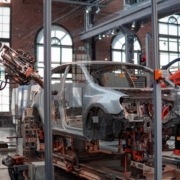Getting started with Lean.
Many companies start working with Lean in good spirits every year to determine after 2 years that it does not want to stick. What is the essence of Lean and how can I anchor it structurally.
Lean is not about the techniques or the tools. Those are just tools. Lean is a philosophy that aims to change the “Thinking” but especially the way of “Behaving” in the organization. Then it is not just about the workplace, but also about management and directors.
Need for Lean
Organizations and the environment in which they operate can be compared to life. Constantly moving, things are constantly changing. Survival of the fittest – the ability to adapt. Think of rapidly changing customer demand, technological developments, the financial crisis of recent years, but also climate change will have an ever greater influence on your organization and supply chain. The many companies where I visit wholeheartedly endorse this starting point, but if you look at everyday practice, little remains of those good intentions. Where does it go wrong?
Case Food
To give you an idea, I take you to a food company, bakery products, where I did an optimization project a few years ago. It was a bit confused when I heard the local plant manager. Enough numbers, solid presentation but the results were sad. It was due to the outdated machines according to the plant manager and the poor work mentality of the employees.
After this explanation and the usual coffee I got a tour of the shop floor. When I entered the production hall I was immediately nailed to the ground. Slightly bewildered, I stared at my shoes. At least to the dry product I waded through. The plant manager saw my bewilderment and laughed. He had already solved that. He proudly showed a suction system that was attached to the walls, so that the product waste could be sucked up and transported to an outside container. He then sold that to the local cattle farms.
Well I was mistaken, it was not a food company but a cattle feed company.
When I looked around further I saw the product flying off the bend on different lines due to the excessive speed of the tracks. Very special was that one job that suddenly stopped. At the end there was a large gray box, you know it from the mail, and it contained the product. Every 15 minutes, one of the employees got up, took that bin and brought it to a line that did go through to a packing machine.
Yes the plant manager said. We were not good and conversion would be too expensive …….
This plant manager was so focused on his numbers and maximizing his output from his bakery machines that he forgot to apply a good line balance and listen carefully to his people who knew where the problem was. And who were therefore no longer motivated at all. Something you can hardly blame them under the circumstances.
Three blocks.
Looking back at this case, but also other processes where organizations are stuck, there are 3 important issues that come back every time and block a successful process:
Many change processes are not developed and executed on the floor itself, but often in separately operating project teams. Important people are removed from the line and placed in the project team. Because project teams like to deliver a complete story, communication between project team and the organization is often poor. The lid is kept on the well. A rumor flow and resistance build-up is the result.
Another point is that people don’t feel taken seriously. Employees are often allowed to participate, but have no material influence on the final decision. So why should those employees worry? In that respect, dare to place more responsibility, but also ownership, on the employee himself. Don’t be afraid of mistakes, we all make them.
The cow trade that often arises when the project is transferred to the line organization. To avoid resistance, changes are often made to the change proposals, which reduces the result of the project accordingly. A prelude to a project that gets bogged down in good intentions.
And the actual culture change that must take place disappears among the many presentations, meetings and spreadsheets.
Way to change
The added value of a Lean process, or any other optimization process, must not only be sought in the end result, but in the path and development towards it. It is about jointly developing an image [what kind of organization you want to be], implementing it and making it transparent to the organization. These 4 pillars are important in this respect.
Always wonder and question
Keep thinking, wonder and keep asking questions. Why does the process work the way it does, why does it take so long, why don’t we use another supplier, etc., but also take a closer look at your meetings and reports. Everyone should be with them always and everywhere. And couldn’t the documentation and reports be simpler? In short, how do you realize that maximum added value for your customers
Many improvements are often a matter of common sense. A lot of improvement knowledge is in the workplace. Employees tend to cut corners. In other words, they know ways to make things easier and faster for themselves. Take advantage of that knowledge. Be tactful in this. Employees quickly become suspicious and distrustful. Challenge them to get started with those questions, let them think up and record the questions themselves. Improvement starts in the workplace. Above all, be there a lot and build your relationship with the employees. Spreadsheets tell you how it was yesterday. You can determine what it will be like tomorrow in the workplace.
Keep it concrete
You do not build a team on the heath or in long sessions. You build a team on the work floor where you focus on the primary process and with the team clearly have the objectives in mind. So focus !. Always try to be as concrete as possible, work towards the result with your people.
Because in order to gain support and to anchor the new way of working structurally, it is important that you undergo and experience the change together with the staff. And yes, then things go wrong. But that is the essence of learning. Guide your people in this as well. Keep stimulating and inspiring. Keep asking questions and looking for better solutions. No matter how small they are sometimes.
Communication
Communication is more than just the formal meeting, the dashboard or action lists. Be open and transparent, keep the process of communication open. By being approachable, looking for contact and not waiting for them to come to you. Remember that employees perceive a natural distance because of the hierarchy in the organization. Even though your door is literally open, only the most cheeky walk in. You will not hear the rest. Not because they have nothing to report, but because they have threshold fears. Find your employees and look for the answers together
Leadership
Yes leadership. A lot is written about it and many have an opinion about what it really is. An unambiguous answer cannot be given. From my experience I have established that integrity, to which credibility is linked, is an essential condition for getting people on board.
It is about being honest and reliable. Keeping to agreements. And be a good example when it comes to norms and values. Who believes that Lean is important to you if your desk can pass for a landfill? Or if the kilos of finished product are on the production floor or the cleaning of the warehouse is not a priority? It is about your behavior and attitude at that time.
So what about your management qualities? Are you too non-committal or too strict? And do you communicate well? are you the right person to realize the change in mentality? Do you dare to look in the mirror or do you also point to the workplace, for which you are ultimately responsible?
An uncomfortable question perhaps, but Lean starts by getting to know yourself. Ask yourself those questions that you would also ask your staff. A company cannot be a little Lean.
The philosophy
Because Lean is not an ordinary cost-cutting program, no quick fix and certainly not a perfunctory round. If that is your starting point, then you will definitely get stuck. The most important thing about the Lean philosophy is that you keep asking questions. We continue to wonder why the processes are carried out in this way and what it will be like tomorrow. Implementing lean is like the waves that wash up on the beach. Continuous, an endless stream of improvements that you make. Most of which will be very small steps.
And improving people is not so much about hiring the smartest and most educated people. It is about the right attitude within your organization. Taking responsibility to do a little bit better every day.
To give you an idea: When Toyota opened its 1st factory in the United States, they spoke to 13,500 people for just 275 functions. They were not looking for the smartest people, but the people who would fit in with their philosophy.
Persistence is an important condition in this. Because there are days when everything goes wrong, nothing works and Murphy knocks on your door all day. Then you must persist, continue to investigate and ask questions. Just as life is constantly looking for solutions, to adapt in a continuously changing environment. In short, your entire organization is constantly looking for improvements and solutions.
This is a representation of the presentation I gave on November 13 at the Logistica fair in the Jaarbeurs in Utrecht.









